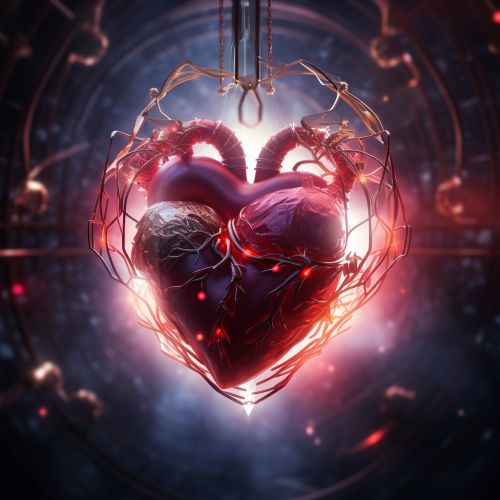Heart arrhythmia
Overview
Heart arrhythmia, also known as cardiac dysrhythmia or irregular heartbeat, is a group of conditions in which the heartbeat is irregular, too fast, or too slow. A heart rate that is too fast – above 100 beats per minute in adults – is called tachycardia, and a heart rate that is too slow – below 60 beats per minute – is called bradycardia. Many types of arrhythmia have no symptoms. When symptoms are present, they may include palpitations or feeling a pause between heartbeats. More seriously, arrhythmia can cause fainting, shortness of breath, or chest pain. While most arrhythmias are not serious, some can predispose to adverse outcomes, including stroke or cardiac arrest.


Types of Arrhythmias
Arrhythmias are classified by the speed of heart rate and by the location of the electrical activity within the heart that causes the arrhythmia. There are four main types of arrhythmias: premature (extra) beats, supraventricular arrhythmias, ventricular arrhythmias, and bradyarrhythmias.
Premature (Extra) Beats
Premature beats are the most common type of arrhythmia. They are harmless most of the time and often don't cause any symptoms. When symptoms do occur, they usually feel like a fluttering in the chest or a sensation of a skipped beat. Most of the time, premature beats need no treatment, especially in healthy people.
Supraventricular Arrhythmias
Supraventricular arrhythmias are tachycardias (fast heart rates) that start in the atria or the atrioventricular node (cells located between the atria and the ventricles). Types of supraventricular arrhythmias include atrial fibrillation (AF), atrial flutter, and paroxysmal supraventricular tachycardia (PSVT). AF, the most common type of serious arrhythmia, is a fast, irregular rhythm where single atrial cells have taken over the rhythmic beating of the heart causing the ventricles to beat irregularly and often rapidly.
Ventricular Arrhythmias
Ventricular arrhythmias start in the heart's lower chambers, or ventricles. They include ventricular tachycardia and ventricular fibrillation. Ventricular fibrillation is a life-threatening condition that requires immediate medical attention.
Bradyarrhythmias
Bradyarrhythmias are slow heart rhythms, which may arise from disease in the heart's electrical conduction system. Examples include sinoatrial node dysfunction and heart block.
Causes
Arrhythmias can be caused by many different factors, including:
- Heart disease: This is the most common cause of arrhythmias. Other heart-related conditions can also trigger arrhythmias, such as high blood pressure, changes to your heart's structure, and heart attacks. - Certain substances or medications: These include alcohol, caffeine, nicotine, over-the-counter medications, prescription medications, dietary supplements, and drugs of abuse. - Stress and anxiety: Some people may experience heart rhythm disturbances linked to psychological stress or anxiety. - Certain medical conditions: Conditions such as diabetes, sleep apnea, and hyperthyroidism can all cause arrhythmias.
Diagnosis
Arrhythmias are diagnosed using a variety of tests. These may include:
- Electrocardiogram (ECG): This is the most common test for diagnosing an arrhythmia. It records the electrical signals in your heart. - Holter monitor: This portable ECG device can be worn for a day or more to record your heart's activity as you go about your routine. - Event monitor: This portable ECG device is intended to monitor your heart activity over a few weeks to a few months. - Echocardiogram: This noninvasive exam, which includes an ultrasound of your chest, shows detailed images of your heart's structure and function.
Treatment
Treatment for arrhythmias can include lifestyle changes, medications, invasive therapies, electrical devices, or surgery. The goal of treatment is to often reduce symptoms and prevent future problems.
